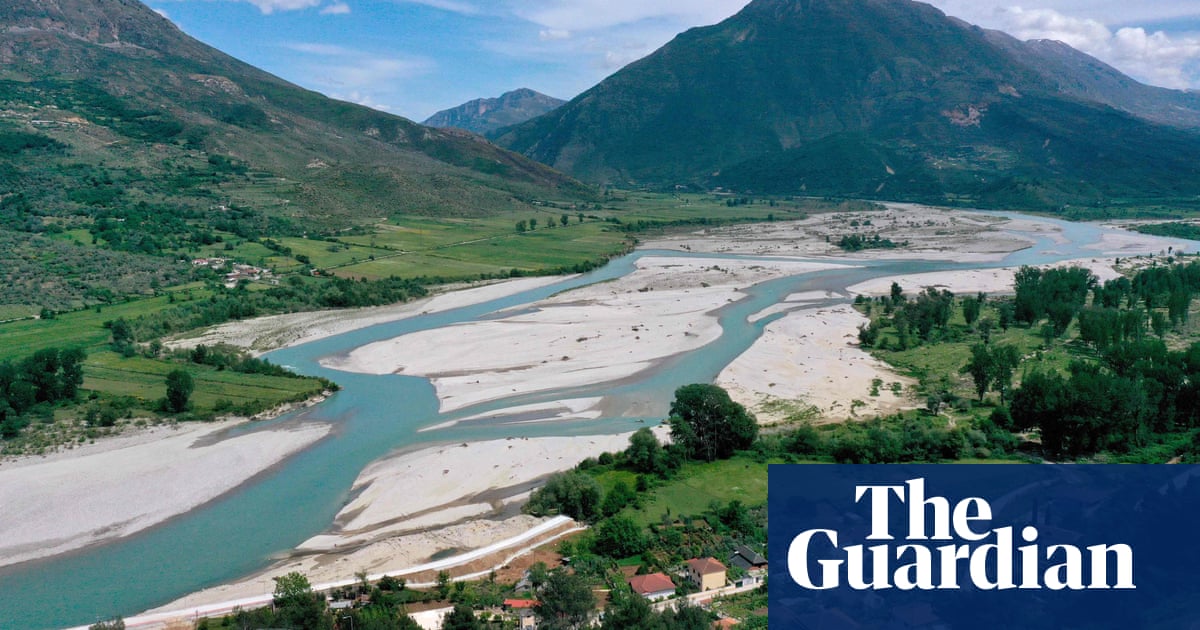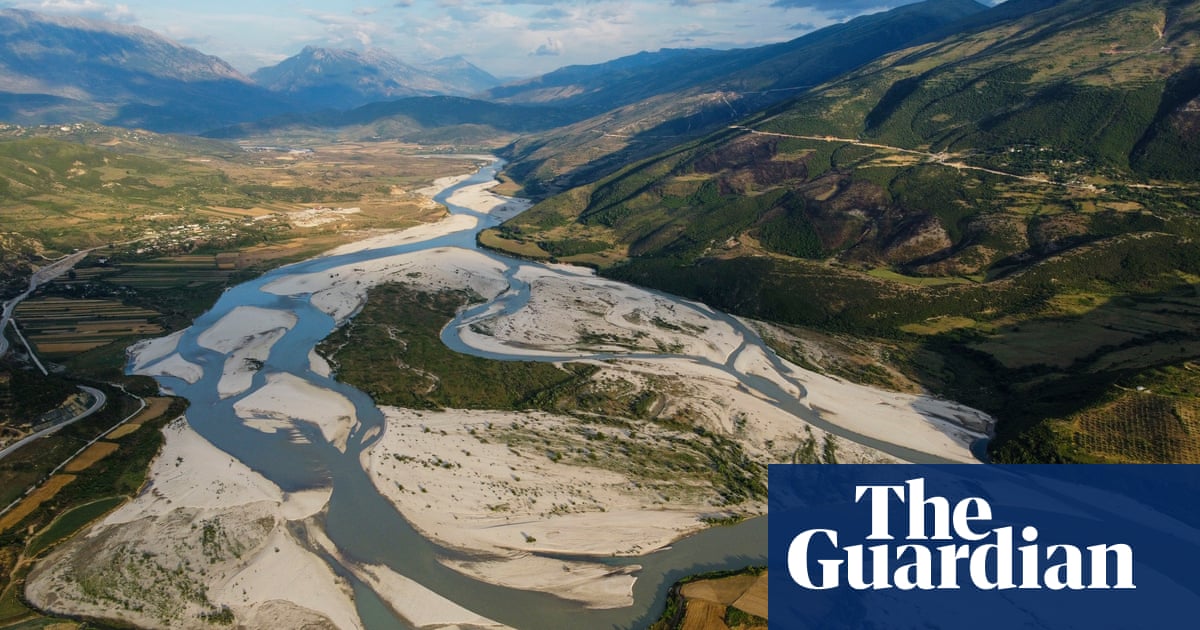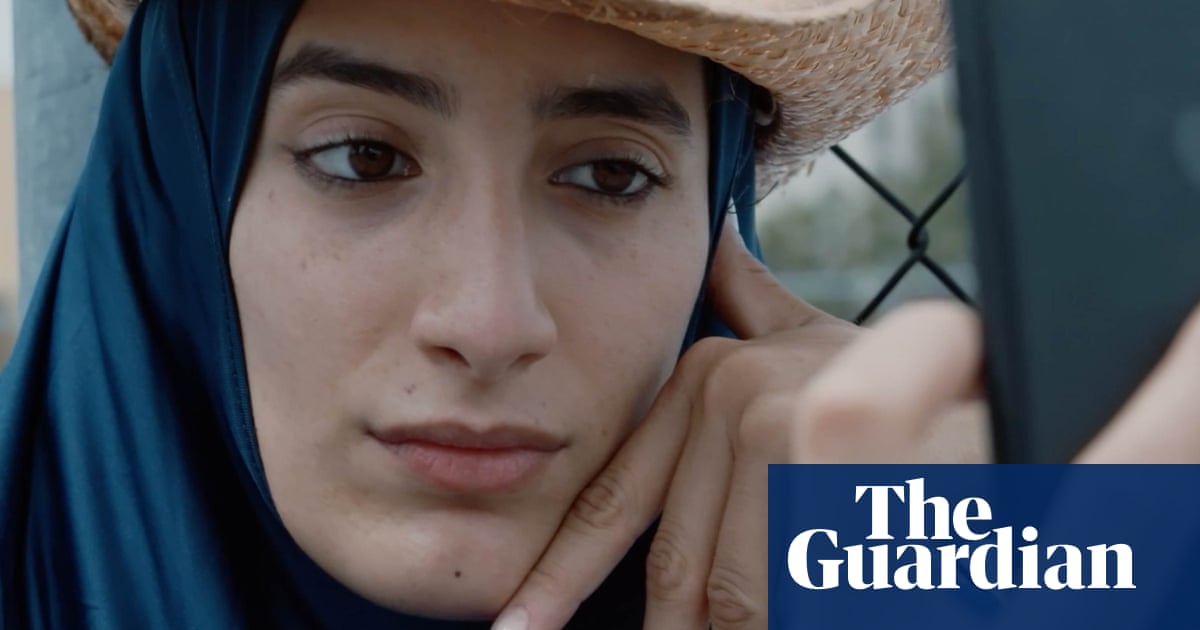
The fast-moving Vjosa River in Albania curves and braids, sweeping our raft away from the floodplain towards the opposite bank, and back again. The islands that split the waterway in two are temporary, forming, growing, then dissipating so that this truly wild river, one of the last in Europe, never looks the same.
“There’s a saying, ‘you can’t step in the same river twice’,” says Ulrich Eichelmann, the head of Riverwatch, a Vienna-based NGO for river protection, who is paraphrasing the Greek philosopher Heraclitus. “A river is a living, dynamic thing, an architect of its surroundings. It changes all the time. That’s its beauty.”
We are heading down a stretch of the Vjosa, a biodiversity hotspot, near Queserat, southern Albania, against the snow-capped Maja e Këndrevicës mountain, to get a sense of the magnitude of the announcement last week of it becoming the first wild river park in Europe. It was a victory that could so easily have been lost.
Eichelmann points out the gravel islands where stone curlews lay their eggs, and gorges where peregrine falcons nest. Complex underwater habitats support critically endangered European eels, whose numbers have dropped 95% since the 1980s, as they migrate the 270km (168 miles) upstream to the river’s source in the Pindus mountains in Greece.
For almost a decade, Eichelmann and his allies from the Save the Blue Heart of Europe (STBHE) coalition, including EcoAlbania and EuroNatur, have campaigned relentlessly against what they call the “hydropower goldrush” in the Balkans, where its most pristine and biodiverse rivers are threatened by more than 3,000 proposed dams.
On Wednesday, they celebrated their part in what Albania’s prime minister, Edi Rama, called a “truly historic moment” for nature. A collaboration between the government, international experts, STBHE, NGOs, the International Union for Conservation of Nature (IUCN) and Patagonia, the outdoor clothing company and environmental organisation, will help ensure the Vjosa and its unique ecosystems across the 12,727-hectare (31,500-acre) park are safeguarded. The park has been given an IUCN category II designation aimed at protecting it from dams, gravel extraction and other damaging activities.
At one point, there were 45 dams proposed on the Vjosa, eight on the main river and 37 on its tributaries. By far the largest was the 50m-high Kalivaç hydropower plant, a few kilometres downstream from Queserat village. You can still see the terraces cut into the hills on either side of the river, while long-forsaken earth movers remain on one bank, left by an Italian company that began the work in 2007, before abandoning it. In the river beyond, the arm of a yellow Caterpillar digger lies, half submerged.
“That’s the bugger!” Eichelmann says, when he catches sight of the machine in the distance. “It is a symbol of the fight – but the river won.”
“If the Kalivaç dam had been built, the area below would be 30-35 metres underwater,” he adds. “It would have drowned the river.”
While the Vjosa supports a myriad of wildlife, including otters, critically endangered Balkan lynx and endangered Egyptian vultures, the key to its biodiversity lies under the water. In the gravel, mussels work away in the dark, filtering the river water, allowing fish to spawn and breed.
The dam “would destroy the whole system”, says Eichelmann. “The water won’t be clean, the gravel will get clogged. The dam will accumulate sediment and the whole thing would collapse. A reservoir might look beautiful, but underneath it’s stagnant.”
After the failed Italian project, the Albanian government, which sources almost all its domestic energy production from hydropower, granted a concession for the building of the dam to a Turkish-Albanian consortium in 2017.
Ulrika Åberg, a project officer at the IUCN, says: “When people talk about hydropower as renewable, they say: ‘It’s just water, it’s the same water in the system.’ But what it does to a river is not renewable. It destroys habitats that have built up for years.”
An hour and a half’s drive through winding mountain passes from Kalivaç is the village of Brataj, on one of the Vjosa’s main tributaries. A small sign fixed to a concrete building reads: “Jo HEC-e Në Shushicë”, meaning no hydropower on the Shushicë, another of the Vjosa’s tributaries.
Qemal Malaj, 61, the mayor of Brataj, who is involved in the ongoing fight to stop a dam being built on the Shushicë, said he was happy the Vjosa’s main tributaries, including the Drino and the Bença, were included in the park.
“We have fought, so far, not to destroy the Vjosa and it is good. The Shushicë is vital for us. We depend on the water for irrigation, for farming. We are strongly against hydropower.”
If the planned dam on the tributary is built, it would divert the river 7km downstream and bring no profit to the community, who are interested in developing river-based tourism.
The marathon campaign to get protected park status for the Vjosa involved years of protests, lawsuits and investigations questioning the environmental impact assessments submitted by hydropower companies. It drew support from scientists, EU parliamentarians and celebrities, including Leonardo DiCaprio. In 2018, Eichelmann accompanied international scientists to the Vjosa’s banks to conduct sampling. They found 1,000 species of plants and animals, 13 of which were threatened globally.
In 2019, a study predicted that, after 45 years, the dam would silt up, reducing energy output. In 2020, the government rejected the environmental impact assessment from the Turkish-Albanian consortium and said the Kalivaç dam would not be built.
But, after eight years of campaigning, there was little trust between the NGOs and the government. Patagonia’s involvement was a “gamechanger”, according to Olsi Nika, hydrobiologist and founder of EcoAlbania.
“They worked as mediators,” says Nika. “In the acid environment between government and civil society, relations were not the friendliest.”
In the small developing country of 2.8 million people, where the legacy of communism three decades ago still lingers, the river park is no mean feat.
But not everyone is happy. Greek NGOs say a 20km stretch of the river, called the Aoos in Greece, remains unprotected until the planned Aoos-Vjosa transboundary park is established. The park does not cover the river’s delta, or stop plans for an international airport in the Vjosë-Nartë protected area, an important refuge for flamingos, pelicans and hundreds of migratory birds. Environmentalists are concerned it may open the floodgates for future development on the Adriatic coast.
At the ceremony launching the park in Tepelenë last week, Rama made clear Vlora airport, an early electoral promise and already under construction, was non-negotiable. A file “as big as a mountain” had been prepared on the airport’s environmental impact, he said, adding that the project “in no way is a threat to the ecosystem”.
Asked if the river delta would gain protection in the future, Rama told the Guardian it would have to be “examined thoroughly”.
“Other countries have managed to harmonise both,” Rama said. “We don’t see any risk there. Some people need to understand, they can’t ask everything, everywhere, from our country.”
Zydjon Vorpsi, an ornithologist at PPNEA, which campaigns for the protection and preservation of the natural environment in Albania, says: “The big problem is, with the airport, the government has set a precedent of building in a protected area, when something is needed that will serve development. The Vjosa River will not be safe if, tomorrow, it will be Vjosa’s turn. The Vjosa cannot be wild without its delta, an integral part, where the river ends.”
A few months after the airport tender was announced, authorities removed protection for part of the nature reserve where the airport lies. The European Commission said the government’s approval went against international and national laws.
The river NGOs say they will continue to campaign for “every inch” of the delta to be protected, for phase II of the national park.
Ryan Gellert, the CEO of Patagonia, said while he was “not crazy” about the airport, it was always one of the Albanian government’s red lines.
“I want to see as much of the delta protected as much as possible,” he said. “But that’s the second phase.”












